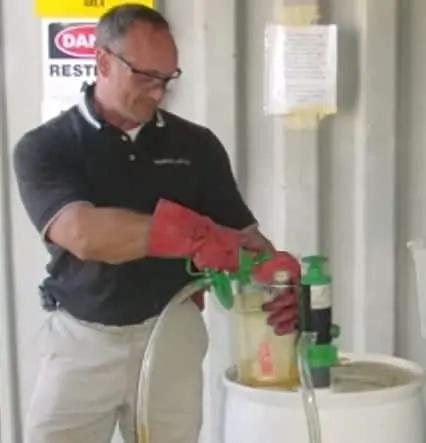CALIFORNIA PESTICIDE REGULATIONS LEAD WATER FACILITY TO CONTROL MORE THAN JUST WEEDS
Aside from running this California water and wastewater management facility, one ongoing challenge for the plant manager in a San Joaquin Valley plant has been controlling the abundance of weeds which grow around the large perimeter of the wastewater treatment site. The hundred-acre facility serves 1.5 million people, with a processing rate of 1.5 gallons per-day- per person. The treatment facility includes 20 acres devoted to the treatment plant and another 10-acre facility to service an adjacent prison. To keep the growth at bay, the staff performed frequent applications of Roundup® weed killer. Purchasing the chemical in large drums, the manager found that the regular hand pumps used to transfer the liquid into dispensing sprayers were not only difficult and messy for the employees, but much of the chemical was wasted in the transfer process due to spillage from a lack of control over the amount of fluid being dispensed. Contributing to the problem was the fact that within a few uses, the chemicals in the weed killer corroded the transfer pumps which then had to be discarded into the landfill and replaced with new ones several times a year. Further, California pesticide regulations were being increasingly enforced in businesses serving the p
Early in 2006, with frustration growing at the chemical mess, the danger to employees and the environmentally unsustainable practices, the plant manager knew he had to find a better solution. His research led him to a hand pump which pressurized a drum, and, through a remote discharge tap with finger tipped controlled shut-off valve and 5 feet of flexible tubing, dispensed the Roundup® directly to the dispenser sprayer with no splashing.
That was three (two) years ago and the staff is not only still using that original pump for Roundup®, management went on to replace pumps in six other chemical applications around the facility with their new found pump. Finding the pump to be a safe, efficient and easy solution, the facility now also uses them for caustic soda used for cleaning bio-growth from diffuser blades and for both d-limonene and petroleum-based degreasers.
“When you find something that works that well and saves you money, you immediately want to use it anywhere you can. The great thing is that the pumps allow staff to transfer fluids efficiently from upright 55-gallon drums. No more dangerous tipping and tapping,” says the plant manager.
These pressure action pumps help companies address their escalating concerns about environmental health and safety by eliminating dangerous chemical spills, on-site pollution and dangerous VOC’s . Their pressurized efficiency enables companies to empty drums of chemicals to the R.C.R.A. (Resource Conservation and Recovery Act) empty standards, eliminating costly waste disposal. When properly maintained, the pumps can last for up to ten years reducing the amount of waste put in to landfills.